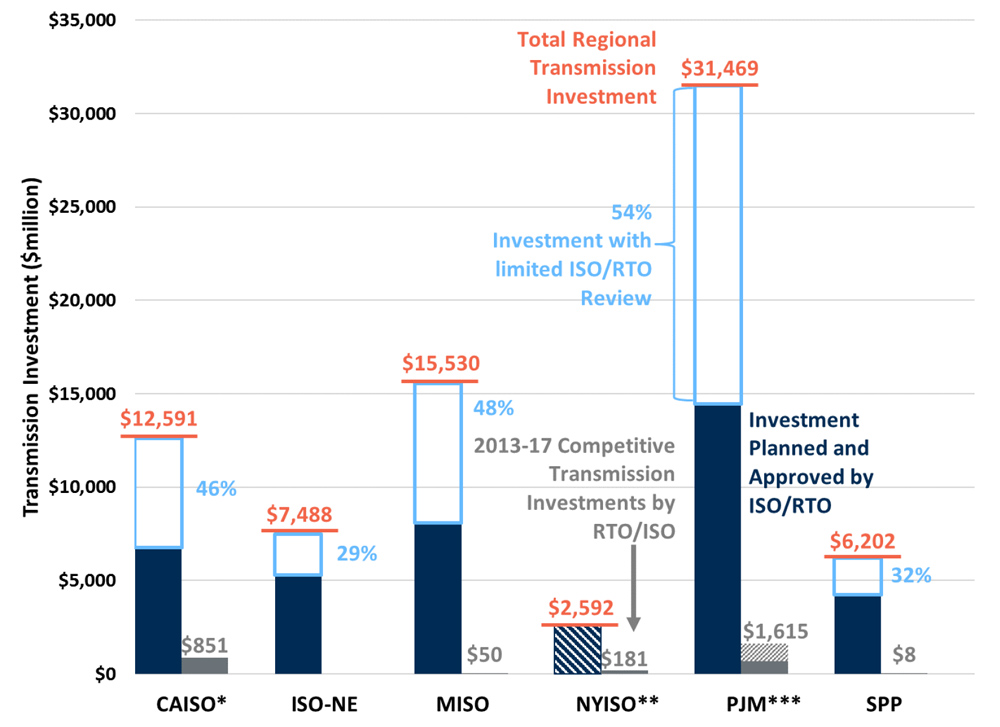FERC voted 3-2 Thursday to update its 1999 policy statement on natural gas infrastructure certificates (PL18-1) and released guidance on how it will evaluate the impacts of projects’ greenhouse gas emissions in its environmental analyses (PL21-3).
The updated policy statement concludes an effort begun in late 2017 under Chair Kevin McIntyre that languished under successor Neil Chatterjee before being restarted almost exactly a year ago by Richard Glick. (See Glick Hits ‘Refresh’ at 1st FERC Open Meeting.)
Combined with the new guidance on GHG emissions, however, it begins an era in which the commission will more closely scrutinize gas projects, including the evidence for their need and their emissions’ impacts on global climate change.
Glick and his fellow Democratic commissioners, Allison Clements and Willie Phillips, said the statements would provide more certainty for pipeline developers. Glick in particular pointed to numerous projects that have been remanded or vacated by federal courts because of insufficient environmental analyses by regulators including FERC.
“In my opinion, the courts have been clear: We have an obligation under both [the National Environmental Policy Act] and the Natural Gas Act to consider the impact of reasonably foreseeable greenhouse gas emissions, and if we were to continue to turn a blind eye to climate change and greenhouse gas emissions, we would simply be adding to the legal uncertainty of these orders approving a project,” Glick said during the commission’s monthly open meeting Thursday.
But Republican Commissioners James Danly and Mark Christie blasted the new policies, saying that FERC was essentially rewriting the Natural Gas Act and attempting to prevent more gas pipelines from going into service.
“I happen to agree that reducing carbon emissions that impact the climate is a compelling policy goal,” Christie said. “But the commission does not have an open-ended license under the U.S. Constitution or the NGA to address climate change or any other problem the majority may wish to address. … Here’s an inconvenient truth: If Congress wants to change the commission’s mission under the NGA, it has that power; FERC does not.”
More than Precedent Agreements Required
Among the most significant changes in the updated policy statement is that FERC will no longer solely rely on precedent agreements as evidence of need for the project.
Such agreements are private contracts between project developers and prospective customers of the project’s gas. But the courts have reprimanded the commission’s reliance on them as indicators of need because they are often between affiliates: developers essentially selling pipeline capacity to themselves.
“Although precedent agreements remain important evidence of need, precedent agreements alone often may not be sufficient to establish need for a project,” FERC staff said in a presentation to commissioners. “The updated policy statement further encourages applicants to provide specific information detailing how the gas to be transported by a proposed project would ultimately be used, why the project is needed to serve that use and the expected utilization rate of the project.”
The update also lists four major public interests that the commission will consider in determining whether a projects’ benefits outweigh its adverse impacts: those of the applicant’s existing customers; those of existing pipelines and their captive customers; the environment; and those of landowners and surrounding communities, including environmental justice communities.
A FERC fact sheet states that “the commission’s consideration of landowner impacts will be based upon robust early engagement with all interested landowners and continued evaluation of input from landowners throughout any given proceeding” and that it will take into account “what a pipeline applicant already has done to acquire lands through good-faith negotiation, as well as an applicant’s plans to minimize the use of eminent domain upon receiving a certificate.”
Impact on Climate Change
FERC said its new policy for analyzing climate impact is considered “interim”; it asked for public comment by April 4.
Under the new policy, FERC will presume that projects with estimated GHG emissions of at least 100,000 metric tons of carbon dioxide equivalent per year will have a significant impact on climate change — requiring that the commission conduct an environmental impact statement — unless the developer can rebut that presumption with evidence.
The commission also stamped a policy long sought by Democrats: It will consider all “reasonably foreseeable” GHG emissions that would result from the project, including those resulting from the downstream use of the gas being transported.
Republican Dissent
Danly’s and Christie’s statements during the open meeting criticized both policy statements collectively; their dissents, along with the statements themselves, had not been published as of press time.
Both Republicans criticized the statements as vague and ambiguous and said the majority was overstepping the commission’s legal authority.
“It is very difficult for us to achieve the objectives of the Natural Gas Act, which is to encourage the orderly development of natural gas infrastructure … when we are adopting policies that are either vague or make it difficult to rationally allocate capital,” Danly said. “I think that it is inevitable that these policy statements are going to chill investments, and that they are going to do so when we have areas of the country facing … constraints in gas supply. …
“It is troubling to me that implicit in these two policy statements is what appears to be a displacement of congressional declaration of the importance of natural gas with the commission’s seemingly implicit declaration instead that natural gas is harmful or negative and needs to be discouraged as much as possible.”
The Republicans also lambasted their colleagues for implementing the interim policy immediately, despite being subject to revision, not just on new applications, but on those pending as well.
“Changing the rules in the middle of the game violates any serious principle of due process, regulatory certainty and just basic fairness,” Christie said.
Sabal Trail
Speaking to reporters by conference call after the meeting, Glick said Danly and Christie spent much of their dissents essentially disagreeing with three of the D.C. Circuit Court of Appeals’ rulings, especially the 2017 Sierra Club v. FERC ruling on the Sabal Trail pipeline.
It was this case that sparked the ongoing dispute over the commission’s analysis of gas project’s GHG emissions. The issues of whether and how FERC should or even can analyze a project’s downstream emissions has been debated ever since. During his time in the minority, Glick repeatedly insisted that the Republican majority was ignoring the court’s directive for FERC to consider the impact of a project’s emissions on climate change when evaluating it. (See EBA Panelists Debate Role of FERC in Regulating Carbon.)
In his dissent, Danly called the decision an “outlier,” arguing that “it is very much in tension with prevailing Supreme Court precedent.”
“We should not rest too much weight upon Sabal Trail,” Danly wrote. “Not only is the holding narrower than the majority seems to believe and was roundly criticized by the accompanying dissent, its reasoning has since been called into question by another appellate court, and I expect it will soon be challenged in the Supreme Court.”
In his statement during the meeting, Christie argued that there is no explicit court directive, noting that “since Sabal Trail, there have been more recent opinions from the U.S. Supreme Court itself reasserting its major-questions doctrine.” Also known as “the major rules doctrine,” it holds that “major questions of public policy” are reserved for Congress, not the executive or judicial branches, to answer. It came back to the fore of the court with King v. Burwell, which ruled on provisions of the Patient Protection and Affordable Care Act.
The doctrine is a check on Chevron deference, in which the courts defer to an executive agency’s interpretation of a statute.
“Whether this commission can reject a certificate to build a natural gas facility, one that otherwise meets the criteria for approval under the Natural Gas Act, because of its alleged impact on global climate change, is clearly a major question of public policy,” Christie said. “I cannot think of a more important question of policy — not just energy policy, but economic policy and, yes, even national security policy.”
Glick countered that “it’s kind of the height of arrogance, I think, to say, ‘Well the court got it wrong, so I’m going to ignore the court.’” The major-questions doctrine is irrelevant, he argued, because Congress in the NGA has already directed FERC to consider whether the public benefits of a project outweigh its negative impacts.
Glick also said the prediction that the Supreme Court would overturn the D.C. Circuit is also irrelevant. The Republicans “may be right; I don’t know. … But in the meantime, we’re bound” by the current ruling, he said.
Temporary Spire Certificate Remains
The commission on Thursday also responded to arguments raised on rehearing of its December order issuing a temporary certificate to Spire STL Pipeline to allow it to continue operating (CP17-40-012).
In June, the D.C. Circuit ordered FERC to vacate its decision permitting the 65-mile natural gas pipeline, saying the commission had failed to follow its own rules on evidence of a need for the facility (20-1016).
Spire announced plans for the project in 2016, but when its “open season” failed to produce any shippers wanting the capacity, it signed an agreement with one of its affiliates for 87.5% of the line’s capacity. In granting the project a certificate of public convenience and necessity, FERC failed to consider “plausible evidence of self-dealing,” the court said. (See DC Circuit Slaps FERC on Pipeline GHG Analysis.)
On Dec. 3, however, the commission granted Spire a temporary certificate, finding that an “emergency” exists because if the pipeline were to cease operations, Spire’s Missouri affiliate would lose gas supply, “potentially impacting hundreds of thousands of homes and businesses during the winter heating season.”
Requests by the Environmental Defense Fund and others to rehear the Dec. 3 order were automatically rejected when the commission did not act on them within 30 days.
In Thursday’s order, the commission rejected the challengers’ request for a stay of the temporary certificate and responded to EDF’s request that it immediately address the self-dealing issue.
“While allegations of self-dealing must be taken seriously and merit additional consideration by the commission on remand of the certificate order, that issue is not relevant to the question addressed by the commission in this proceeding: whether to issue a temporary certificate in the heart of winter where the health and welfare of hundreds of thousands of customers is at stake,” FERC said.
Rich Heidorn Jr. contributed to this report.



